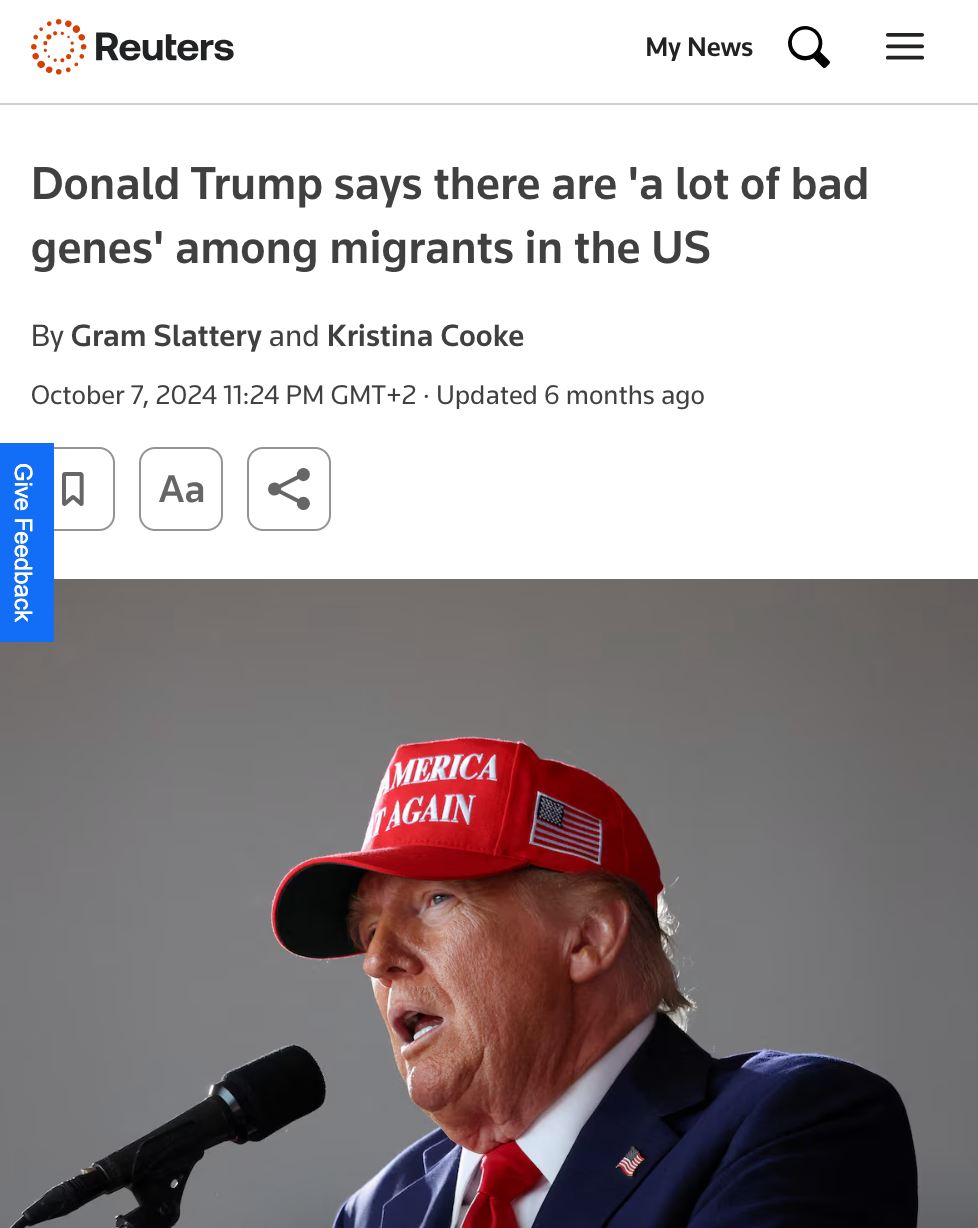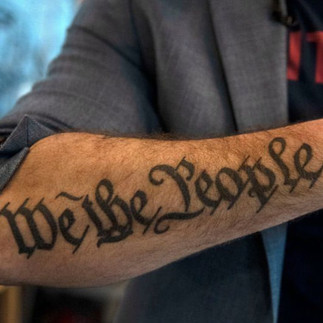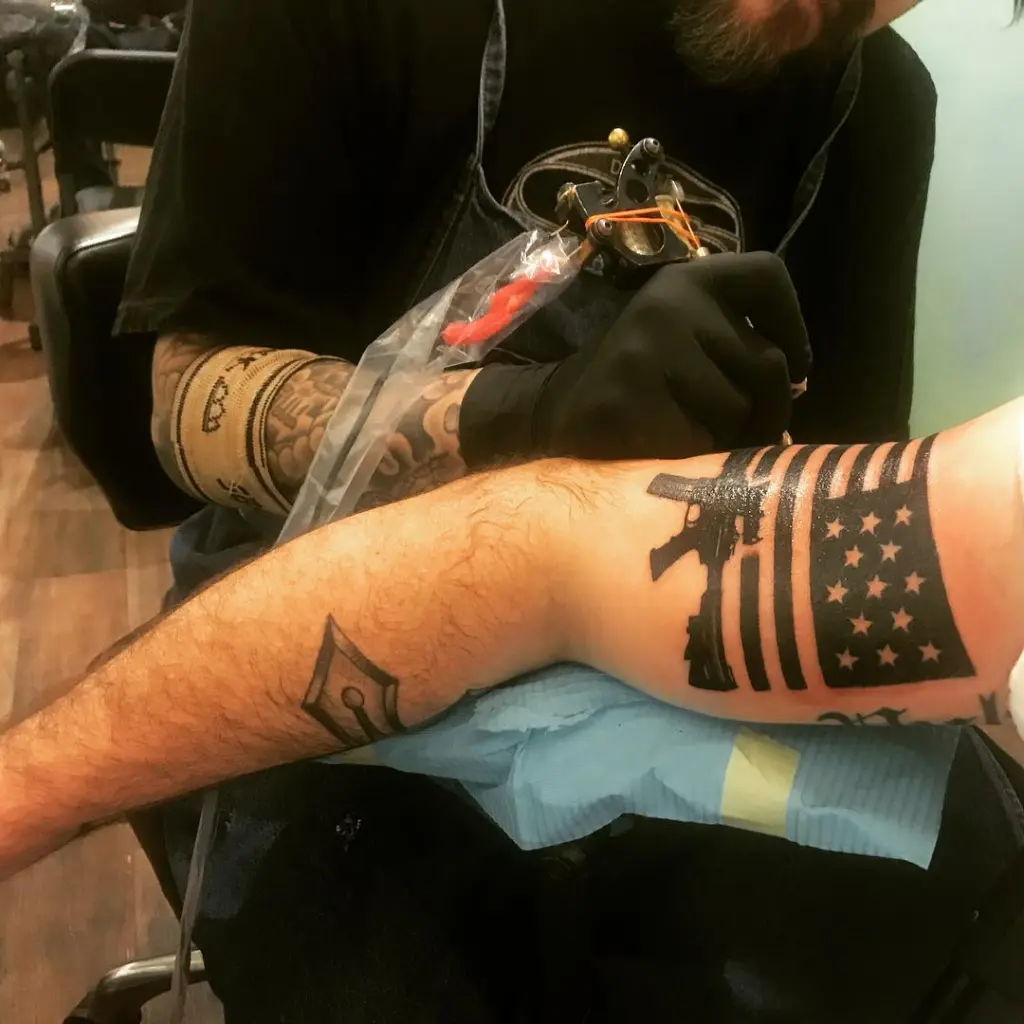Op-Ed: How Trump’s America is Marching Toward a Holy War
- Tiffany Oldani

- May 1
- 11 min read
Updated: Aug 22

At first, it was just a joke. Donald Trump would wink at rallies, throw out lines about “maybe” staying in office past his term limits, and let his loyalists work themselves into a froth over the idea of an unbreakable Trump dynasty. “Twelve more years!” they’d chant. He’d smirk, play along, and the crowd would roar.
But now, the joke is starting to read less like humor and more like foreshadowing for what’s to come. Trump now insists he’s “not joking” about his bid to bypass the Twenty-Second Amendment, the constitutional guardrail limiting presidents to two terms. The United States, once seen as a beacon of democracy, is shifting under his influence, with the very principles of constitutional governance now up for debate.
To his most fervent supporters, Trump is more than a leader, he’s a savior figure. In his most recent inaugural address, Trump referenced the assassination attempt against him the year prior, declaring that he was “saved by God to make America great again.” Beside him stood Vice President JD Vance, as Rev. Franklin Graham offered a prayer: “We ask that you would bless him, and bless our nation through him,” invoking a powerful biblical image of Vance “holding up [Trump’s] arms like Aaron held up the arms of Moses in the midst of battle.” Paula White, a longtime spiritual advisor and former head of the White House Faith and Opportunity Initiative, has said his presidency carries “the hand of God,” casting Trump’s rise to power as an act of divine providence.
These statements reflect a broader narrative embraced by many who see Trump as a vessel for restoring what they believe are America’s Christian foundations. Trump’s own rhetoric and policies increasingly reflect this belief. His hardline, often extralegal approach to immigration is reshaping the fabric of the nation, while his foreign policy gestures revive echoes of pre–World War II expansionism.
What Trump is leading now is not simply a political campaign, but a movement. One where religion and nationalism merge, and where the road ahead could lead not just to authoritarianism but to something closer to a holy war.
The War On Minorities
America is a nation built by immigrants. The Statue of Liberty stands as a beacon of that legacy, bearing Emma Lazarus’s famous words: “Give me your tired, your poor, your huddled masses yearning to breathe free.” But under the renewed Trump administration, that promise is being systematically dismantled.
What was once a stringent immigration policy has now hardened into something far more aggressive and ideologically driven. In just the first days of Trump’s second term, immigration raids have escalated, sweeping up not only undocumented migrants, but also U.S. citizens and legal residents. The recent raid in Newark, New Jersey, is a chilling example of this shift: indiscriminate detentions that blur the line between law enforcement and political purge. The message is clear: the country is no longer open to all.
In March, the case of Kilmar Abrego Garcia made headlines, a story that harkens back to the racially profiled internment camps of World War II. A legal resident of Maryland, Garcia was wrongfully deported to a notorious El Salvador prison on the unfounded suspicion that he belonged to the MS-13 gang. No evidence was ever presented. “This was an illegal act,” according to U.S. District Judge Paula Xinis, condemning the deportation as “unconstitutional.” Abrego Garcia had been living with his wife and children, all U.S. citizens, when ICE agents detained him.
This is no isolated incident. Since Trump returned to office, U.S. Immigration and Customs Enforcement (ICE) has been deporting at record levels. Few groups have felt the heat more than Muslim immigrants. Under new executive orders, even those in the process of obtaining lawful residence are now being scooped up in mass deportation efforts.
This aggressive approach has also encompassed international students and scholars who have criticized Israel’s military campaign in Gaza, predominantly Muslims. Mahmoud Khalil, a Columbia University student and legal U.S. resident, was detained and faced deportation after participating in protests against Israel's military actions in Gaza. Similarly, Rümeysa Öztürk, a Turkish national and Tufts University graduate student, was detained by masked individuals on the street near her residence. Her detention followed her co-authorship of an op-ed calling for the university to divest from companies doing business with Israel. These cases exemplify the administration's use of immigration enforcement as a tool against political dissent.
In cities across America, heightened ICE activity has created an atmosphere of fear and uncertainty. Neighborhoods with minority communities have seen a noticeable drop in public activity, with residents avoiding schools, workplaces, and public spaces due to fear of ICE raids that sometimes target families who have followed every rule—only to be told the rules no longer matter.
The crackdown hasn’t just shattered lives; it has cracked the economy, too. In Florida, where agriculture and construction have long depended on immigrant labor, businesses are floundering. You might think this would inspire a policy rethink, but no. Instead, Republican lawmakers have come up with an unconventional solution: relaxing child labor laws to fill the void. In multiple states, teenagers as young as fourteen are now legally allowed to work overnight shifts
So why, if it causes such economic strife, is Trump doing all of this? The goal appears to be a systematic excision of ethnic and religious minorities.
The draconian turn in immigration policy stems from a long pattern of racially charged and Islamophobic rhetoric that has defined Trump’s political rise. In one of the most chilling examples yet, Trump remarked in October 2024 that some migrants “have bad genes,” suggesting that criminality and moral deficiency are hereditary traits in certain ethnic groups. “We got a lot of bad genes in our country right now,” he said, language reminiscent of early 20th-century eugenics, the pseudoscience once used to justify some of history’s more horrific atrocities.
Trump’s Islamophobic statements have been just as explicit. From his 2015 call for a “total and complete shutdown of Muslims entering the United States” to his baseless claim that “Islam hates us,” he has repeatedly rallied his base by stoking fear of Muslims and casting Islam as adversarial American ideals.
In March 2025, he boldly accused a Jewish political opponent of being “Palestinian,” using the identity itself as a slur. Meanwhile, he has consistently amplified the white nationalist “great replacement” theory, framing immigration as a conspiracy to dilute white political power.
These are not idle words; they form the foundation of a political vision that blurs the line between policy and persecution—a vision made all the more evident by those he has chosen to lead the nation.
“Make the Crusade Great Again”
If you take a look at Trump’s inner circle, you’ll notice something that marks a sharp break from the secular traditions of recent U.S. politics: his advisors are wearing their faith, quite literally, on their sleeves. Christian symbolism, once seen as a breach of the constitutional divide between church and state, has become a conspicuous feature of the Trump administration’s public image. Cross necklaces have become a signature accessory, worn by figures such as White House press secretary Karoline Leavitt and Trump's legal advisor, Alina Habba.
For them and others in the circle—like Secretary of State Marco Rubio—the public display of faith is not merely personal but a calculated political move. As Trump vowed, he is bringing religion back, and bringing it back stronger. These expressions of faith serve as visual markers of allegiance, shorthand for the religious nationalism that has come to define the administration’s rhetoric.
No one embodies this trend more than Pete Hegseth, the Secretary of Defense. Hegseth, a former Fox News, has covered his body in tattoos that read like a crash course in far-right symbology.
Hegseth is also the author of American Crusade, published in 2020. In it, he portrays Islam as a historical adversary of the West and idealizes medieval crusaders. He intertwines conspiracy theories reminiscent of the "great replacement" narrative, suggesting a collaboration between liberals and Muslims to undermine the United States.

Historians and experts have publicly criticized Hegseth's perspectives as being Islamophopic and filled with historical inaccuracies, expressing deep concern over the implications of his views on international relations and military policies, especially in the Middle East.
He writes, in a chapter aptly titled “Make the Crusade Great Again”:
“By the eleventh century, Christianity in the Mediterranean region, including the holy sites in Jerusalem, was so besieged by Islam that Christians had a stark choice: to wage defensive war or continue to allow Islam’s expansion and face existential war at home in Europe,”
“The leftists of today would have argued for ‘diplomacy’ … We know how that would have turned out.”
Hegseth continues: “The pope, the Catholic Church, and European Christians chose to fight – and the crusades were born…Pope Urban II urged the faithful to fight the Muslims with his famous battle cry on their lips: ‘Deus vult!,’ or ‘God wills it!’”
Hegseth proudly sports this crusader battle cry on his body in one of his many tattoos. In fact, Hegseth’s tattoos have become something of a visual manifesto. Alongside patriotic imagery, like the phrase “We the People,” an American flag wrapped around an AR-15 rifle, and Benjamin Franklin’s “Join, or Die” serpent, are symbols with overt religious and militaristic undertones. There’s the Jerusalem Cross, historically linked to Christian crusaders; a cross entwined with a sword, evoking the Gospel passage where Jesus declares, “I did not come to bring peace, but a sword” (Matthew 10:34).
The most alarming declaration on his body is the Arabic word kafir, meaning “infidel,” or in other words “disbeliever in Islam” inked in bold script on his right arm. For a senior government official, the tattoo carries a clear message—and for many observers, a deeply troubling one.

Critics have pointed out that some of these symbols, particularly when clustered together, mirror imagery used by far-right and white nationalist groups. Variations of them have appeared at events like the 2017 Charlottesville rally, in the manifesto of Norwegian shooter Anders Breivik, and even on the weaponry used in the 2019 mosque attacks in Christchurch, New Zealand. While Hegseth has not endorsed such groups, the visual parallels have raised concerns about the ideological tone being set at the highest levels of national defense.
In that light, Hegseth’s tattoos reflect a larger vision. One where politics and religion are deeply connected. This hallmark of the Trump administration has not gone unnoticed. In fact, some have plainly stated it.
In March 2025, Archbishop Elpidophoros of America presented President Trump with a Holy Cross, praising his leadership and Christian values. He further compared Trump to Constantine the Great, the emperor who made Christianity the state religion of Rome, saying, "Just as Constantine the Great played a critical role in the rise of Christianity, so too does President Trump in shaping the future of our nation…With this cross, I pray you bring peace to the world, and make America invincible!”
Constantine's reign marked a pivotal moment in both political and religious history - the moment when the Roman Empire became the Holy Roman Empire. He played a central role in shaping the doctrine of Roman Catholicism, laying the foundation for Christianity as we know it today. This historical parallel resonates with many of Trump’s supporters, who see his presidency as a defining moment in America’s evolving Christian identity.
But Trump’s vision isn’t limited to a religious overhaul of America. Much like Constantine, who expanded Roman territory and established new power centers such as his namesake, Constantinople, Trump is focused on territorial expansion. His ambitions challenge the post-WWII consensus of not acquiring territory through force, signaling a break from longstanding norms in U.S. foreign policy.
Trump’s Expansion Ambitions
“One way or the other, we're going to get it.” That was Donald Trump’s startling declaration regarding his renewed push to acquire new territory. Chief among his ambitions is Greenland, an idea he first floated publicly in 2019. At the time, Denmark, which governs Greenland, swiftly rejected the proposal, calling it “absurd.” But Trump wasn’t joking. Following Vice President J.D. Vance’s visit to Greenland in March 2025, Trump stated that military intervention “isn’t off the table” to acquire the territory. When asked how far he’s willing to go, he responded, “We will go as far as we have to go”
Such a move would be a game-changing departure from international understanding. Article 2 of the UN Charter of 1945, states that “all members shall refrain in their international relations from the threat or use of force against the territorial integrity or political independence of any state”. While a forceful takeover of Greenland would shock the world, its strategic value is not hard to understand. Its location in the Arctic makes it a pivotal site for military positioning and natural resource development, especially as melting ice opens new shipping routes and access to untapped reserves. But Trump’s remarks raised concern in Denmark and among NATO allies, not only because of the implications for international law but also the broader message about U.S. territorial ambitions.
Meanwhile, Canada, has found itself in the crosshairs of Trump’s expansion plans. After taking office, Trump promptly imposed a sharp 25% hike in tariffs and other protectionist economic measures, weakening the Canadian economy overnight. His actions appear, to some observers, to be economic coercion. Canadian Prime Minister Justin Trudeau has even suggested that Trump is seeking to trigger “a total collapse of the Canadian economy because that will make it easier to annex us.”
It’s worth noting that Canada’s geographic location is significant. Should the United States acquire Greenland, Canada would find itself situated between two American-controlled territories: Alaska to the west and Greenland to the east. Control over Greenland would grant the U.S. unmatched access to Arctic shipping lanes, surveillance airspace, and forward military positions—essentially tightening American control over the entire North American Arctic perimeter. In this configuration, Canada is no longer merely a neighbor; it becomes a hinge point in a broader realignment of power.
At the same time, Trump’s repeated threats to withdraw from NATO unless allies meet defense spending targets signal a pivot away from the Atlanticist consensus that has defined U.S. foreign policy for decades. His rhetoric, often more conciliatory toward Moscow than Brussels, has raised alarms among diplomats and defense officials who see in it the seeds of a post-NATO world. In that context, Arctic expansion, particularly through Greenland, takes on new meaning. It’s not just about geography or resources, but about building a new security architecture, one in which traditional alliances are weakened and bilateral leverage takes their place. Russia, which has spent years militarizing its own Arctic frontier, would likely welcome this fracturing of Western unity. Trump’s plan to acquire Greenland already has the stamp of approval from Vladamir Putin, himself.
The push for Greenland marks a broader shift in American strategy, where military power, territorial ambition, and economic nationalism are blending into a new vision of American dominance. For Trump’s supporters, it’s a modern-day Manifest Destiny, a belief in a divine mission to remake the world in America’s image. But this time, it’s wrapped in the language of national security and backed by the full weight of a superpower’s resources. The stakes are higher and the ambition more global.
A World on the Brink of War
In the midst of escalating conflicts, from the war between Russia and Ukraine to the unrelenting violence in Gaza, the world order appears increasingly fragile.The EU Commission, bracing for conflict, has begun issuing crisis preparedness guidelines, advising citizens to stockpile food and essentials in case of conflict. The possibility of a larger-scale conflict no longer appears abstract but imminent.
Into this mounting volatility steps the United States not as a stabilizing force, but as a nation undergoing its own ideological transformation. No longer the postwar guardian of global norms, the U.S. under Donald Trump is projecting a new identity.
Trump’s embrace of hard-line Christian nationalism at home and expansionist ambitions abroad suggest a paradigm shift that could reshape the world as we know it. Legislation that once safeguarded against dynastic rule, that separated church from state, or diplomacy from aggression, is being redefined or simply ignored.
There is a familiar pattern emerging—one that echoes the early twentieth century, when economic upheaval, religious zeal, and nationalism converged to pave the way for authoritarian regimes. Across Europe and beyond, fascism was often preceded by a deliberate fusion of religious devotion with state power, cloaked in the language of divine purpose and national rebirth. Expansionism was framed not as a policy, but as a sacred duty. In such a political climate, institutional checks are weakened, opposition is cast as betrayal, and the machinery of democracy begins to turn against itself.
If the trajectory continues, future historians may point to this moment as the inflection point—when the old order collapsed and something fundamentally different began to rise. As with Rome, the shift may not be fully understood until it’s too late to reverse.
If you enjoyed this article, you can order the printed version of our Divine Just State Magazine here. It features this and many other articles, as well as special content.































Die offensichtliche Unterdrückung durch die US Amerikanische Regiegrung ist schockierend. Was jedoch um ein vielfaches schockierende ist, dass die Menschen scheinbar nicht wahrnehmen, wie sie sich selbst daran beteiligen, dass sich die Geschichte der gewaltvollen Durchsetzung des "Stärkeren" wiederholt. Ist der Mensch so kurzsichtig oder so selbstbezogen, oder ist es eine Kombination aus beidem?
Say, do, think and write what you will about the Aryan-descent White ethnopolitical dissidents and other Aryan-descent White folks; however, one of such dissidents had at one point typewritten, that the state has to serve the human racial group, not the other way around. (As an aside, that has to be one of the real lessons from history in general, not merely only the history of imperial China and the history of modern-day China.) In another instance had he written, that when one ceases to worship the state, whether on many grounds or a few, the state ceases to exist; when that happens, it's as if the armed forces and magical weapons made by malspecters were supernormally sabotaged.
Furthermore, I…